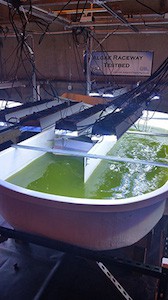Researchers at Sandia National Laboratories have developed a new algae raceway testing facility to bridge the gap between lab and real world. Today, scientists have not yet discovered a cost-competitive way to convert algae to renewable fuels. The new Sandia algae testing facility is comprised of three 1,000-liter oval raceway ponds that feature advanced monitoring.

The new algae raceway testing facility at Sandia National Laboratories will help scientists advance laboratory research to real-world applications. Shown here is one of the three 1,000-liter ponds, outfitted with custom lighting and 24-hour advanced hyper spectral monitoring. Photo credit Dino Vournas.
“This facility helps bridge the gap from the lab to the real world by giving us an environmentally controlled raceway that we can monitor to test and fine tune discoveries,” said Ben Wu, Sandia’s Biomass Science and Conversion Technology manager. “The success of moving technologies from a research lab to large outdoor facilities is tenuous. The scale-up from flask to a 150,000-liter outdoor raceway pond is just too big.”
According to Wu, the “raceway” design features several benefits:
- Easy scale-up to larger, outdoor raceways
- Customizable lighting and temperature controls, operational by year end, to simulate the conditions of locations across the country
- Fully contained for testing genetic strains and crop protection strategies
- Advanced hyperspectral monitoring 24 hours a day
The new facility is already in use with researchers Todd Lane and Anne Ruffing testing genetically modified algae strains as part of a project funded by Sandia’s Laboratory Directed Research and Development (LDRD) program. The algae raceway should enable the researchers to more quickly identify strains that promise improved performance.
“The bioeconomy is gaining momentum,” Wu said. “Biofuels from algae may be further off, but algae has sugar and proteins that can make fuel or higher valued products, such as butanol or nylon — products that currently come from fossil fuels.”
Wu expects the facility will expand opportunities for Sandia researchers to develop algae as a robust source of biofuels and increase collaborations and partnerships with the private sector, particularly in California where efforts to transform transportation energy are prevalent.

